This is the first part of a new series we will be doing on Total Football Analysis. Each week, we are going to look at a woman’s clubs from around the world and break down these sides. The analysis will focus on taking the team’s strengths and weaknesses and finding some of the best tactics used to break them down.
In this first piece, I will be looking at Arsenal Women. The London club has been the dominant side in the FAWSL for many years. Now, though, they are facing stiff competition for their position at the top from the likes of Chelsea Women and Manchester City Women. This campaign we have seen Arsenal struggle more than in previous ones. Joe Montemurro’s side has been frustrated by their title contenders, specifically Chelsea. Elsewhere, Manchester United Women also showed an ability to nullify the Gunners, as chinks in their armour have begun to appear. In this tactical analysis, we are going to take examples from matches against these three sides in particular in building tactics to break down Arsenal Women.
Arsenal’s structure
Before looking at the tactics that have shown their effectiveness in playing against Arsenal Women, it is important to have an understanding of the way the Gunners play. Montemurro has established a set system for his side with only a couple variables depending on the opposition. They will almost always play in a 4-2-3-1 or 4-3-3. The shape of the midfield is based largely on the attacking approach they decide to use. Below you can see the 4-3-3 set-up and how it shifts going into a 4-2-3-1.
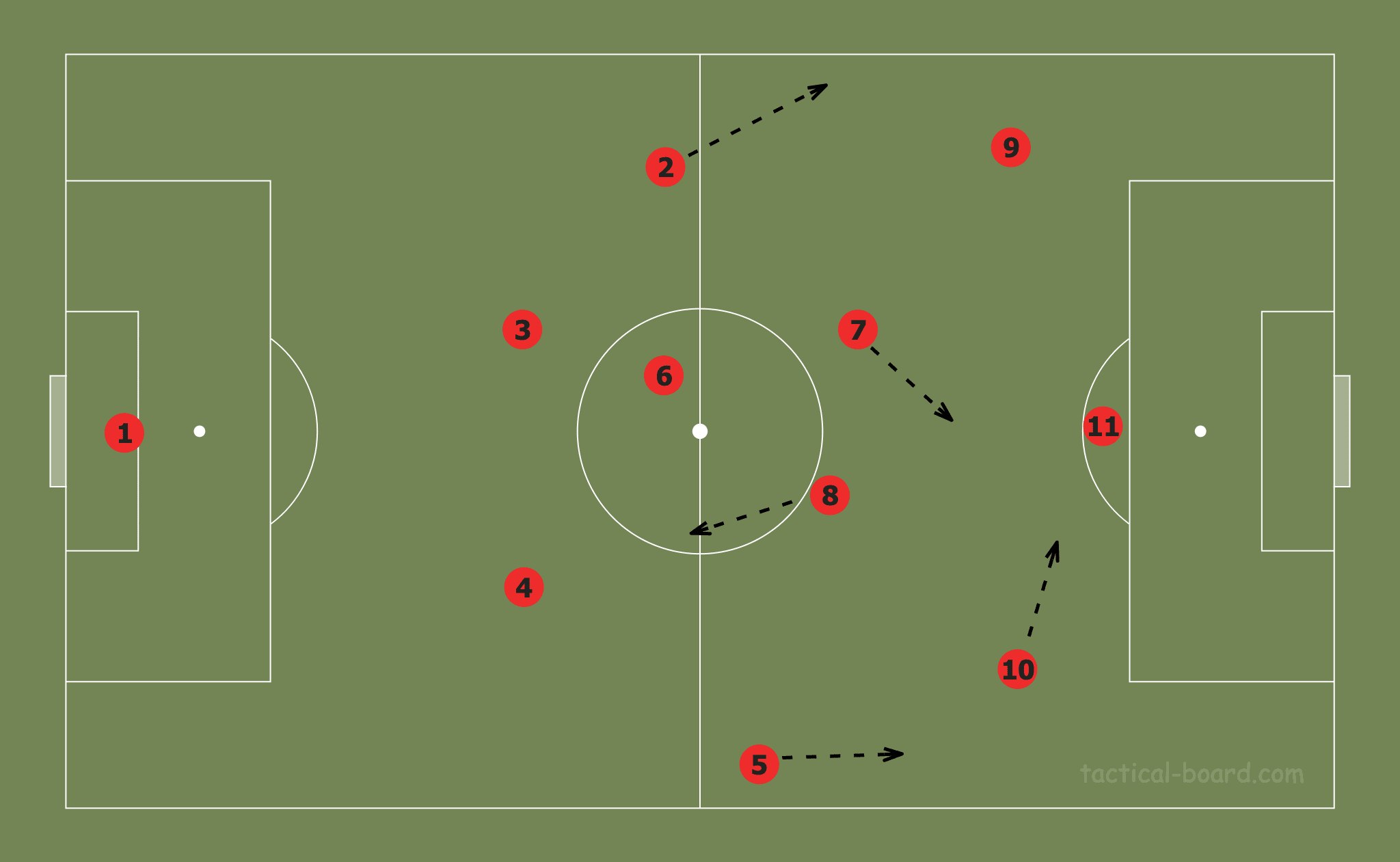
When Arsenal focus their attack centrally they use the 4-3-3- with the central pivot most often. With Walti sitting back in front of the defensive line and one of the full-backs staying in with her, it allows the likes of Kim Little and Jordan Nobbs to move forward into advanced positions in the half-spaces close to the striker. Vivianne Miedema is at her best when she has teammates close around her that she is able to make quick combinations with. A lot of times this will come in the form of these two central midfielders connecting her to the rest of the side.
Alternatively, Arsenal will also look to attack down the channels. With the likes of Katie McCabe and Lisa Evans occupying the full-back positions as the natural wingers they are, it brings a lot of attacking intent and danger. Their willingness to get forward in these areas force opponents to have to move away from a centralised deep block and meet them out here.
The attacking approach using the channels is different on each side due to the wingers. On the left, Bethany Mead is more of a traditional winger. She thrives in providing the width and looking for opportunities to beat her defender in one-v-one situations. Due to this, you will often see her full-back underlapping her movements to take advantage of the half-space. If Mead is able to move inside as she takes on her defender the full-back will then look to overlap and add that extra threat, forcing the opposing defender to have to commit to trying to block this pass or block Mead’s movement into the centre of the pitch.
On the left, Danielle Van de Donk plays the role of a false winger. The Dutch international is traditionally a central midfielder. On the wing, she will often drift inside close to her international teammate Miedema almost as an inside forward. She is most effective in the half-spaces and just in front of the defensive line where she can find holes in the defensive block. This type of player here gives the opponent difficulty in marking. The full-back lined up to her must decide whether to track her inside or pass her off to a teammate who could already be marking another Arsenal player. With McCabe playing in the left-back position, they will often look to take advantage of the space provided in this area by Van de Donk. In either formation used by the Gunners, the left-back is pushed forward and providing the width on this side due to the inverted winger.

When the attack is focused out wide, the double pivot in the 4-2-3-1 becomes more important. This line offers the defensive solidity and protection against counter-attacks. It also frees up the single attacking midfielder to get as far forward as possible. Often, she will move in line with Van de Donk and the two will play just off Miedema up top. They look to move the opponent’s defensive line to create room in behind for their striker to run into. You can see this set-up and the typical player movements associated with it above.
Low block defensive structure
First and foremost against a side like Arsenal Women, your defensive solidity and structure must be intact. All three of Manchester City, Chelsea, and Manchester United based their tactics on this principle when playing the defending champions. Arsenal average 63.47% possession in the FAWSL this campaign, and matches against the big sides in the league are no exception to this, so staying sound on the defensive side of the game is of utmost importance. The first two achieved this defensive solidity during this campaign by using a 4-4-2, with United the only different one using the 4-2-3-1. Because of factors, we will look at in this section and the ones to come, we will focus on the use of the 4-4-2 formation.
Looking at the two lines of four in this formation, organisation is the biggest key to success. As we looked at above, Arsenal are capable of playing both inside and out. However, teams who are able to block the centre of the field have come off much more successful against the Gunners. Forcing them out wide has a number of advantages opposed to letting them work possession through the midfield.
The biggest advantage to this tactic is restricting Arsenal’s ability to get Miedema involved into play. It is easy to classify her as a poacher with the numbers she produces, but she brings so much to the team all around. Her passing and movement are underrated qualities due to her finishing ability. When Montemurro’s side are at their best, Miedema is combining with her teammates close around her to move into the final third. Below you can see Arsenal’s pass map against Chelsea Women earlier this season in a match they lost 4-1. Notice Miedema (#11) and her lack of links to her teammates. This disconnect takes away from Arsenal’s ability to progress play up the field despite the 58.03% possession they held against their rivals.
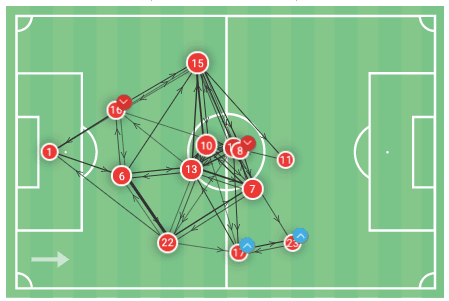
The centre-halves must man-mark the Dutch international to achieve this. Between the two players, they are best off acting as cover shadows against Miedema. Her turn of pace is not the quickest so you can afford to play her closer and try cutting out passing attempts, with the other centre-half aware of the tactic and in position to cover in the event of her teammate getting beat. Ahead of them, the two central midfielders are the most crucial to the entire set-up as they are tasked with defending two or sometimes three of Nobbs, Little, and Van de Donk. Keeping a close distance between them and the defensive line limits the space Arsenal’s danger women have to work in. The benefits of this are taking away their ability to get on the ball, or forcing them to get on the ball in areas that are not dangerous. In the pass map above against Chelsea Women, notice the size of the circles for the midfield players. This represents the impact in the passing game they had, and in the pass map, you are able to see the success Chelsea had in limiting this route for their opponents. Below is another example, this time against Manchester City Women. The big focus in this image is the positioning of Van de Donk (#7). The midfielder-turned-winger played in a position closer to her natural one in the centre of the park for this match but was marked out by Nick Cushing’s side. This forced her to drop deep to look to get on the ball to try and make an impact on the match. However, City were more than happy to allow the Dutch international to get on the ball in this area as they had the whole of their defensive structure in front of her.
Focused press
With the midfield and defensive line holding firm against Arsenal’s attacking players, the two strikers have an important role in keeping Montemurro’s side from being able to find a rhythm in their initial possession and build-up. Leah Williamson is one of the best centre-halves in the world in passing out from the back and breaking lines with passes into her midfield and attacking teammates. Because of this, it is very important that sides look to limit her time on the ball. Manchester City, in particular, made this an emphasis in their matches against the Gunners. With Ellen White and Pauline Bremmer up top, one of the two pressed Williamson as soon as she received possession. The other sat deep and moved almost in line with the outside midfielders, who stepped forward to put Williamson off looking for these outlets. Instead, they wanted Beattie on the ball. While astute defensively, her range of passing and ability to pick out teammates in dangerous positions is lacking. Rather, she typically looks for safer passes to the full-backs to take forward or back to Williamson to find these passes herself.
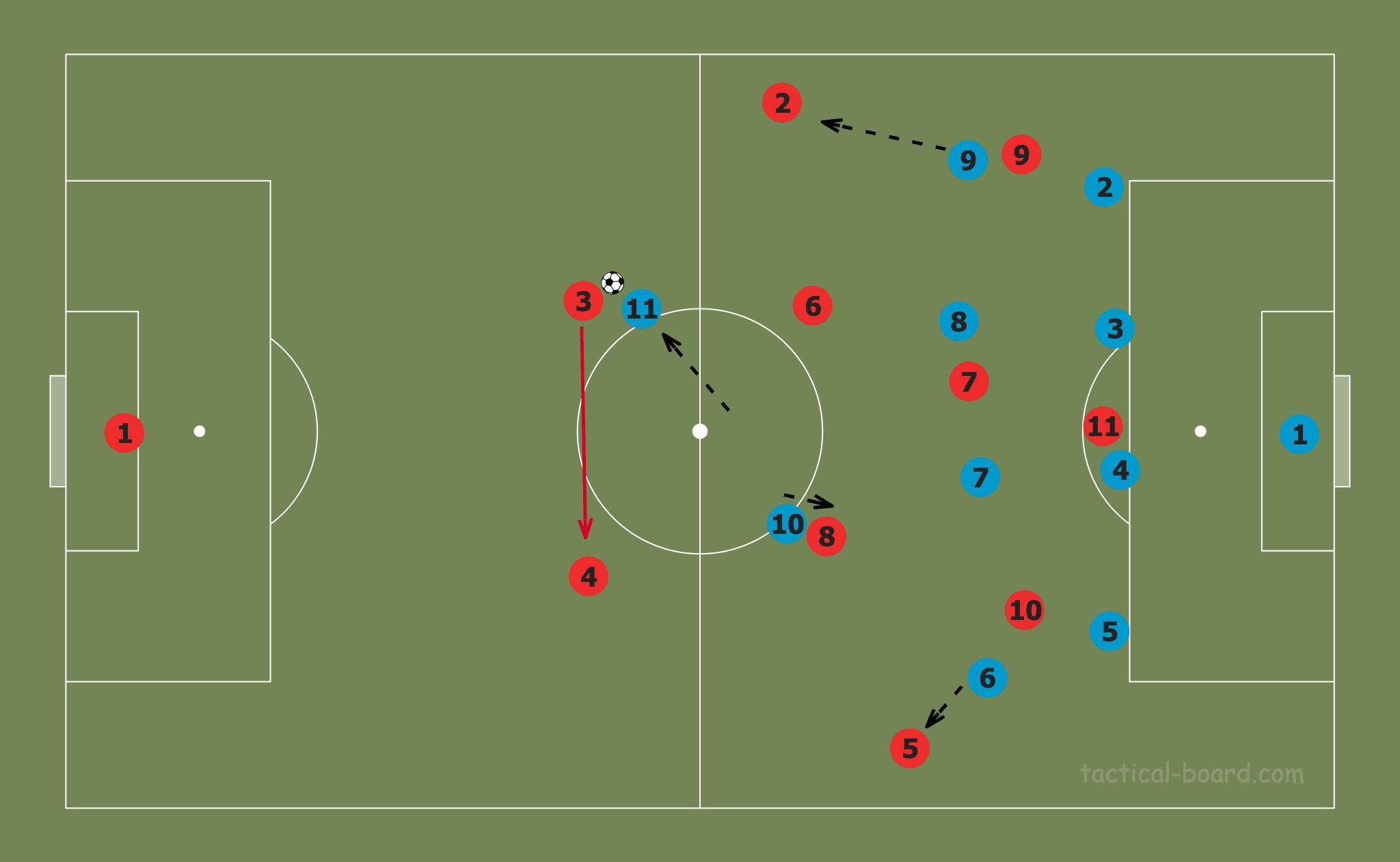
In the image above you can see an example of this. As possession is played into Williamson (#3), the lead striker jumps forward to press her immediately. As she does this, it triggers the outside midfielders to step forward behind the Arsenal full-backs to act as cover shadows. If possession is played into these areas they can look to intercept the pass and get their side on the counter or stay reserved and simply just restrict any forward movement from there. The second striker tucks in a bit centrally and encourages the pass into Beattie (#4). Once this pass is made, the press will then look to surround her and force her into making an error trying to play forward or pass it back to her goalkeeper.
Overloading the midfield
With the defensive phase of the match covered, we now will look at how to look at attacking Arsenal Women. As mentioned above, the Gunners hold the majority of possession in their matches, so it is important to be effective when the opportunity comes to have the ball.
Arsenal like to press high, specifically in the midfield. The three in this area look to force opponents backwards by blocking off forward passing lanes and not giving any time on the ball to their opposition. A tactic used by Chelsea Women due to this was inverting their outside midfielders when possession was established. With this, Sophie Ingle dropped in and they created a 4-1-2-1-2 formation that was very narrow. The positive of this tactic was the numerical advantage it created in the middle of the park. This allowed Chelsea to progress through the areas of the pitch into the final third by always finding the extra player in the midfield.
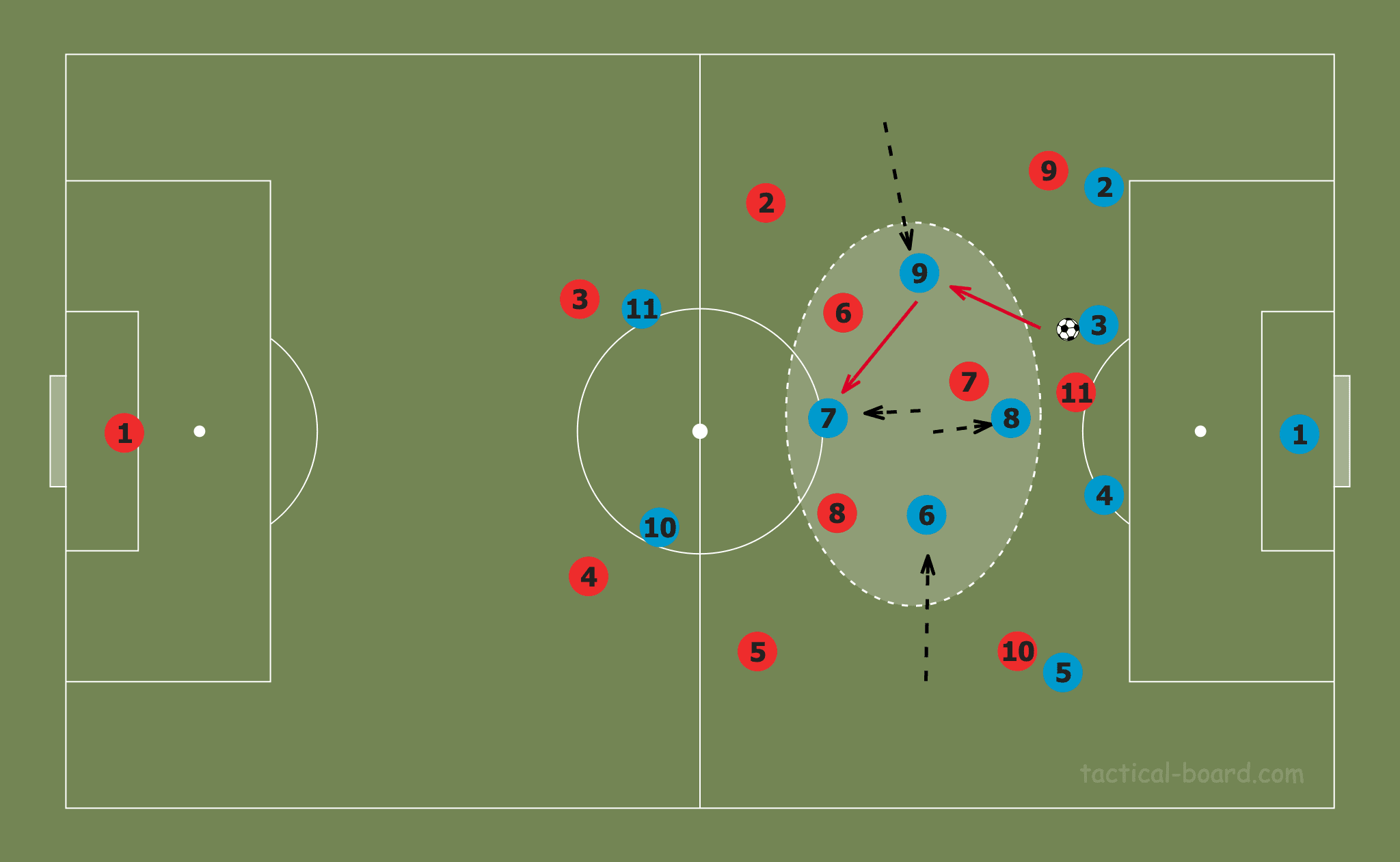
You can see this in the image above. With the outside midfielders moving inside, the two central midfielders also split vertically. This provides the side with the ability to create a number of different lines in this midfield area. It also creates a variety of passing lanes for the deep central midfielder and the centre-halves to look for as they look to progress play forward. Once the initial pass is made into one of the two outside midfielders, the most advance midfielder can look for space on either side of Walti to receive a second pass and look to move into the attacking phase of the game.
Isolating the full-backs
While the personnel at full-back give Arsenal Women an extra dimension on the attacking side of their game, it can work against them on the other end. Looking to attack Arsenal Women, the most success can be found down the channels and in the half-spaces.
Chelsea used a very interesting tactic in exposing these areas in their 4-1 defeat over the Gunners. With the compact midfield we discussed earlier to help progress play forward, they needed alternatives to provide the width. Emma Hayes side has full-backs that are traditionally more defensive than a lot that we see in this day and age, so it was the strikers that were used to look to get into these areas.
When Chelsea progressed through the middle third of the pitch, the two strikers would look to split. This is a tactic we see a lot in sides such as the North Carolina Courage and is very effective in these narrow formations. For the NWSL Champions, their box midfield means they do not have natural wide wingers, so when possession is played through the middle and progressed, the strikers peel off either side to give the players in possession options and not allow the defence to collapse inwards on them, rather having to respect a wide option.
Chelsea Women did this in a very similar way. When a player got free in the midfield with space to work, Bethany England and Sam Kerr both moved onto the far sides of the centre-halves. Here they stayed on the shoulder and gave options to the player in possession. She could either look to play them in behind or pass to their feet to hold possession and allow the rest of the team to get forward. Alternatively, because of the two strikers movement, the centre-halves were unable to step forward onto the player on the ball. If either of Williamson or Beattie looked to do this, Kerr or England would move into the resulting space in behind and take advantage immediately.
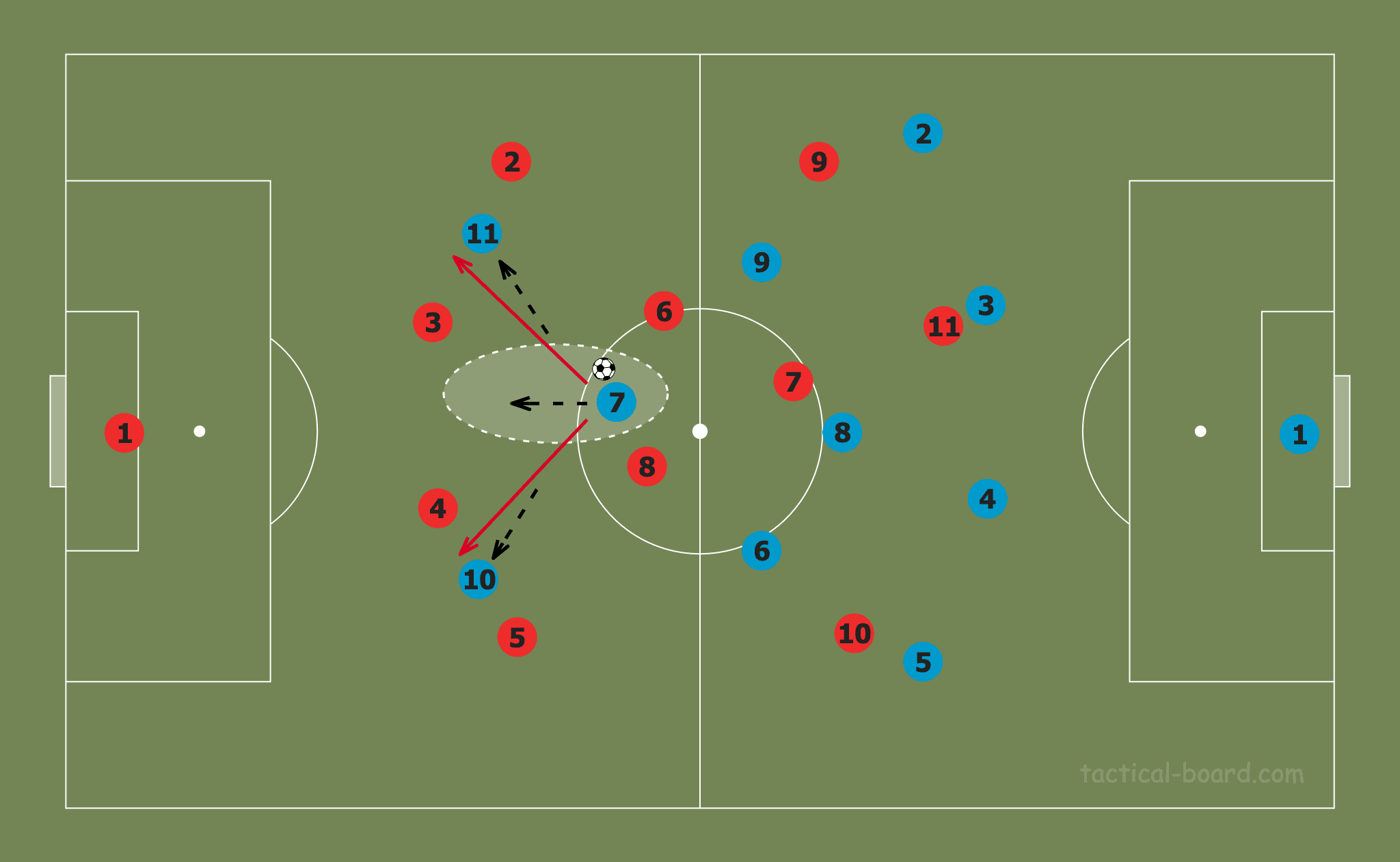
Above you can see this idea. With the attacking midfielder receiving possession behind the Arsenal midfield, the two strikers split wide into these half-spaces. The space is open in front of the two centre-halves and forces Williamson and Beattie to make a big decision on allowing the player to drive forward or try and meet her while not allowing a pass in behind.
Counter-attacking is another possibility to take advantage of against Arsenal Women’s system. Because of the marauding full-backs in their system, space to counter-attack in is out wide. On the same idea as above, the strikers can be quick to look to move into the channels upon possession being regained. The idea behind the strikers looking to use this space is to not disrupt the midfield lines. Having the outside midfielders being able to focus on their defensive duties against the Arsenal full-backs by taking away their need to provide an outlet for the side allows for more stability in this defensive structure.
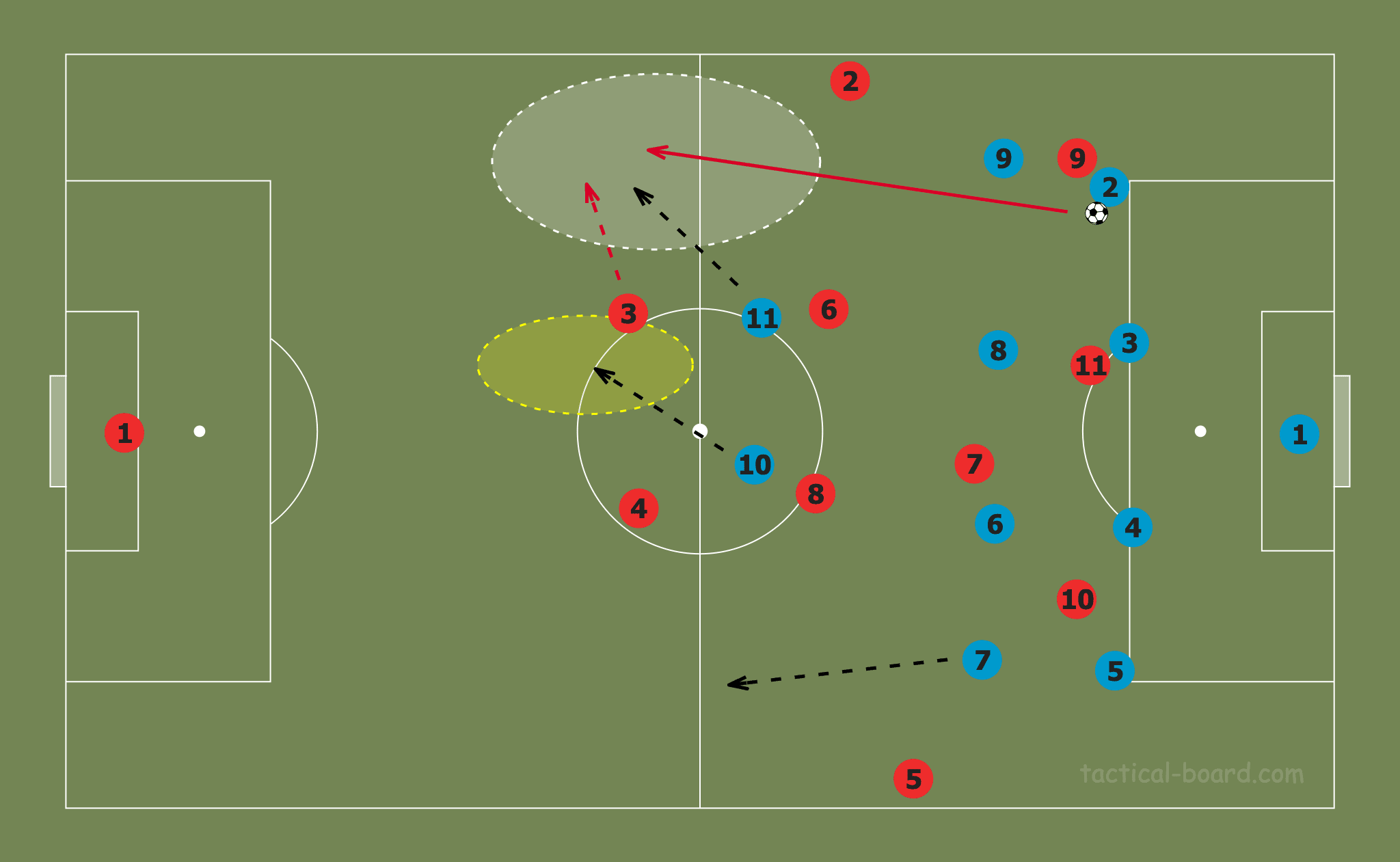
The other idea of this is to disrupt Arsenal’s counter-pressing system. With their compact structure that we described earlier, this will become strained when one of the centre-halves or central midfielders are forced to follow the striker into the channel. This movement can be seen in the image above and has the potential to open up space in the centre of the park for one of the midfielders to move into as the side pushes forward.
The negative in looking to play on the counter is the higher chances you give Arsenal Women to win possession back quickly. Playing longer balls over the top or into the channels give the defensive side a decent chance at winning the ball back for their side and getting back into the attacking phase of their game. If you rely too much on a tactic like counter-attacking against Arsenal they are capable of keeping their opponents pinned in.
Conclusion
Arsenal Women are one of the most dominant sides in Europe. With that, the opposition must get their tactics perfect to be able to beat them. We have seen this from the likes of Chelsea Women and Manchester City Women this campaign. From these matches, there are tactical points that we have taken to come up with a plan to set up against Arsenal in this scout report. Defending organised, winning the midfield battle by creating numerical advantages, and attacking the channels have been successful in coming up against Arsenal and are factors that must be kept in mind going forward.





Comments